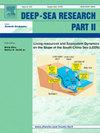海温变化和El Niño现象对波斯湾北部基什岛附近珊瑚礁白化的影响研究:遥感方法
IF 3
3区 地球科学
Q2 OCEANOGRAPHY
Deep-sea Research Part Ii-topical Studies in Oceanography
Pub Date : 2025-09-29
DOI:10.1016/j.dsr2.2025.105550
引用次数: 0
摘要
珊瑚礁是最具生物多样性的海洋生态系统之一,但日益受到环境压力的威胁,特别是由于海面温度上升(SST)引起的珊瑚白化。因此,监测海温变化对珊瑚保护至关重要。本研究使用度加热周指数(DHW)调查波斯湾北部基什岛周围的热异常,该指数量化了珊瑚的累积热应力。1982 - 2022年的海温和DHW数据来自美国国家海洋和大气管理局(NOAA)。使用Mann-Kendall检验和Sen's斜率估计器分析趋势,而使用Pierce技能评分来估计表明珊瑚白化风险的DHW阈值。El Niño现象与DHW之间的关系也进行了评估。利用谷歌地球引擎处理的MODIS Aqua卫星数据分析了海温的时空变化。结果表明,2017年8 - 9月海表温度和DHW的最大值分别为35.17°C和13.6°C-week, DHW呈每年0.025°C-week的上升趋势。DHW阈值估计为5.3°c -周。空间分析表明,波斯湾南部和北部海岸,特别是基什岛附近的热应力正在增加。最后,El Niño事件与DHW值升高相对应,突出了它们对珊瑚白化的影响。这些发现强调了长期监测对减轻气候对珊瑚生态系统造成的威胁的重要性。本文章由计算机程序翻译,如有差异,请以英文原文为准。
Studying the impact of sea surface temperature (SST) changes and El Niño phenomenon on coral reefs bleaching around Kish Island in the northern Persian Gulf: A remote sensing approach
Coral reefs are among the most biodiverse marine ecosystems but are increasingly threatened by environmental stressors, particularly coral bleaching caused by rising Sea Surface Temperature (SST). Monitoring SST changes is therefore critical for coral conservation. This study investigates thermal anomalies around Kish Island in the northern Persian Gulf using the Degree Heating Weeks (DHW) index, which quantifies cumulative thermal stress on corals. SST and DHW data from 1982 to 2022 were obtained from the National Oceanic and Atmospheric Administration (NOAA). Trends were analyzed using the Mann-Kendall test and Sen's slope estimator, while the Pierce Skill Score was employed to estimate the DHW threshold indicating coral bleaching risk. The relationship between the El Niño phenomenon and DHW was also assessed. Spatial and temporal SST changes were examined using MODIS Aqua satellite data processed via the Google Earth Engine. Results show maximum SST and DHW values of 35.17 °C and 13.6°C-weeks in August–September 2017, respectively, with DHW exhibiting an upward trend of 0.025°C-weeks per year. The DHW threshold was estimated at 5.3°C-weeks. Spatial analyses suggest increasing thermal stress along the southern and northern coasts of the Persian Gulf, particularly near Kish Island. Finally, El Niño events corresponded with elevated DHW values, highlighting their influence on coral bleaching. These findings underscore the importance of long-term monitoring to mitigate climate-induced threats to coral ecosystems.
求助全文
通过发布文献求助,成功后即可免费获取论文全文。
去求助
来源期刊
CiteScore
6.40
自引率
16.70%
发文量
115
审稿时长
3 months
期刊介绍:
Deep-Sea Research Part II: Topical Studies in Oceanography publishes topical issues from the many international and interdisciplinary projects which are undertaken in oceanography. Besides these special issues from projects, the journal publishes collections of papers presented at conferences. The special issues regularly have electronic annexes of non-text material (numerical data, images, images, video, etc.) which are published with the special issues in ScienceDirect. Deep-Sea Research Part II was split off as a separate journal devoted to topical issues in 1993. Its companion journal Deep-Sea Research Part I: Oceanographic Research Papers, publishes the regular research papers in this area.

 求助内容:
求助内容: 应助结果提醒方式:
应助结果提醒方式:


